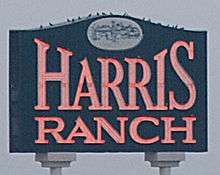Harris Ranch
| Industry | Beef producer |
|---|---|
| Founded | 1937 |
| Founder | Jack Harris |
| Headquarters | Selma, California, U.S. |
Area served | United States |
| Products | Beef |
| Owner | John C. Harris |
Number of employees | 400 |
| Parent | Harris Farms |
| Website |
www |


Harris Ranch, or the Harris Cattle Ranch, feedlot is California's largest beef producer and the largest ranch on the West Coast of the United States, producing 150,000,000 pounds of beef per year in 2010.[1] It is located alongside Interstate 5 at its intersection with California State Route 198 east of Coalinga, in the San Joaquin Valley of central California. The ranch is owned by Harris Farms.
Description
History
Founded by Jack Harris in 1937, the Harris Ranch Beef Company (now operated by Jack Harris' son John) was originally a cotton and grain operation.[1]
The farm also operates an inn and restaurant, raises fruit and vegetable crops, and breeds thoroughbred horses.[1][2] Overall, the operation has more than 400 employees.[3] Approximately 14,000 acres (5,700 ha) are devoted to garlic, broccoli, pomegranates, and tomatoes, among 35 types of fruits and vegetables.[4]
In January 2012, an arsonist destroyed fourteen cattle trucks on the ranch. The Animal Liberation Front claimed responsibility.[5][6]
Marketing and distribution
At over 800 acres (320 ha) and with a population of over 100,000 cattle,[4] and hundreds harvested daily, the ranch is the largest on the West Coast. It is also among the largest (when including density) in the United States. A vertically integrated operation, it owns a fleet of trucks that take cattle from several ranches with which it deals, and does its own finishing, slaughtering, and packaging.[1]
The ranch supplies the hamburger meat for the In-N-Out Burger chain, and also distributes beef and prepared meals through grocery stores and restaurants nationwide.[1][3]
Harris Ranch was one of the first to build a brand around itself as a specialty niche product, and is credited as a forerunner of companies like Niman Ranch and Dakota Beef.[1]
Restaurant and inn
The restaurant was targeted to local farmers when it opened in 1977, but later became popular as a halfway stop on the busy highway connecting San Francisco and Los Angeles.[7][8] A 153-room luxury inn was added in 1987.[4] The restaurant evolved into a "farm to fork" concept in the late 2000s, featuring not only beef but wine and other products made locally by the ranch.[1] As of 2008 the restaurant was the 57th busiest in the United States and sixth busiest in California based on gross receipts.[3] The site was chosen as one of the first battery swapping Tesla stations.[9][10]
Public reception
The ranch is known to travelers for the "ripe, tangy odor of cow manure", described alternately as a "horrible stench"[11] and "a good, honest, American smell".[12] This smell inspired food writer Michael Pollan to conduct the research on factory farming that led to his sustainability book, The Omnivore's Dilemma.[11] The owner of Harris Ranch, in turn, threatened to withhold a $500,000 donation to California Polytechnic University if it sponsored a speech there by Pollan.[13] In reference to the large number of cattle processed at its facilities, some critics[14] have nicknamed the ranch "Cowschwitz",[11] comparing the slaughtering of cows to the slaughtering of Jews during the Holocaust at the Auschwitz concentration camp.[4][15][16] Animal behavior expert Temple Grandin described the nickname as a matter of public misperception, saying that the company "does a great job" of keeping its animals.[17]
See also
Gallery
-

Harris Ranch Inn
-

For most travelers, the feedlot is the most recognizable view of Harris Ranch from Interstate 5
References
- 1 2 3 4 5 6 7 Munoz, Olivia (October 4, 2010). "Harris Ranch markets farm-to-fork". Associated Press.
- ↑ HRBC | About Us | Our History
- 1 2 3 Cary Ordway. "Stop at Harris Ranch like visiting destination resort". California Weekend Getaways.
- 1 2 3 4 Weekend America http://weekendamerica.publicradio.org/display/web/2007/12/21/coalinga/
- ↑ Lee, Henry K. (January 10, 2012). "Animal-rights arson at Harris Ranch?". San Francisco Chronicle.
- ↑ Marble, Steve (10 January 2012). "Animal rights activists take credit for blaze at cattle ranch". Los Angeles Times. Retrieved 11 January 2012.
- ↑ Schwartz, Ariel (February 24, 2010). "Earl Cox's Tesla Charging Station Makes Electric Roadtrip From L.A. to S.F. a Reality". Fast Company.
- ↑ Maybury, John (February 7, 2012). "Wandering and Wondering". Pacifica Tribune.
- ↑ Fehrenbacher, Katie (2013-08-07). "Record sales, upbeat Q2 earnings for electric car maker Tesla". Gigaom. Retrieved 2013-08-08.
- ↑ Tesla Motors Team (2014-12-19). "Battery Swap Pilot Program". Tesla Motors. Retrieved 2014-12-20.
- 1 2 3 Black, Jane (December 7, 2009). "Think you're dining 'green'? Menus won't always tell you". Washington Post.
- ↑ Susan Spano (2006-10-08). "Eat well, sleep deeply off I-5, at Harris Ranch". Los Angeles Times.
- ↑ Enzinna, Wes (November 2010). "Big Meat vs. Michael Pollan". Mother Jones.
- ↑ Estabrook, Barry (December 28, 2011). "Feedlots vs. Pastures: Two Very Different Ways to Fatten Beef Cattle". The Atlantic.
- ↑ Micah Sachs (2005-07-04). "Punk and Stupid". San Diego Jewish Journal.
- ↑ "Sacred cows at Cal Poly San Luis Obispo". Los Angeles Times. 2009-10-16.
- ↑ Mitchell, Larry (February 19, 2012). "Temple Grandin: Ag must make progress known". Chico Enterprise Record.
External links
Coordinates: 36°20′35″N 120°12′54″W / 36.343°N 120.215°W